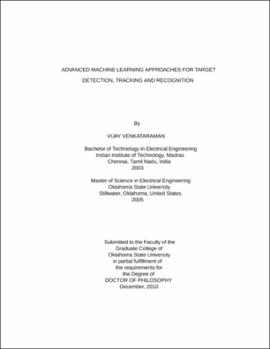| dc.contributor.advisor | Fan, Guoliang | |
| dc.contributor.author | Venkataraman, Vijay | |
| dc.date.accessioned | 2013-12-10T18:05:52Z | |
| dc.date.available | 2013-12-10T18:05:52Z | |
| dc.date.issued | 2010-12 | |
| dc.identifier.uri | https://hdl.handle.net/11244/7875 | |
| dc.description.abstract | This dissertation addresses the key technical components of an Automatic Target Recognition (ATR) system namely: target detection, tracking, learning and recognition. Novel solutions are proposed for each component of the ATR system based on several new advances in the field of computer vision and machine learning. Firstly, we introduce a simple and elegant feature, RelCom, and a boosted feature selection method to achieve a very low computational complexity target detector. Secondly, we present a particle filter based target tracking algorithm that uses a quad histogram based appearance model along with online feature selection. Further, we improve the tracking performance by means of online appearance learning where appearance learning is cast as an Adaptive Kalman filtering (AKF) problem which we formulate using both covariance matching and, for the first time in a visual tracking application, the recent autocovariance least-squares (ALS) method. Then, we introduce an integrated tracking and recognition system that uses two generative models to accommodate the pose variations and maneuverability of different ground targets. Specifically, a tensor-based generative model is used for multi-view target representation that can synthesize unseen poses, and can be trained from a small set of signatures. In addition, a target-dependent kinematic model is invoked to characterize the target dynamics. Both generative models are integrated in a graphical framework for joint estimation of the target's kinematics, pose, and discrete valued identity. Finally, for target recognition we advocate the concept of a continuous identity manifold that captures both inter-class and intra-class shape variability among training targets. A hemispherical view manifold is used for modeling the view-dependent appearance. In addition to being able to deal with arbitrary view variations, this model can determine the target identity at both class and sub-class levels, for targets not present in the training data. The proposed components of the ATR system enable us to perform low computational complexity target detection with low false alarm rates, robust tracking of targets under challenging circumstances and recognition of target identities at both class and sub-class levels. Experiments on real and simulated data confirm the performance of the proposed components with promising results. | |
| dc.format | application/pdf | |
| dc.language | en_US | |
| dc.rights | Copyright is held by the author who has granted the Oklahoma State University Library the non-exclusive right to share this material in its institutional repository. Contact Digital Library Services at lib-dls@okstate.edu or 405-744-9161 for the permission policy on the use, reproduction or distribution of this material. | |
| dc.title | Advanced machine learning approaches for target detection, tracking and recognition | |
| dc.contributor.committeeMember | Hagan, Martin T. | |
| dc.contributor.committeeMember | Cheng, Qi | |
| dc.contributor.committeeMember | Hanan, Jay C. | |
| osu.filename | Venkataraman_okstate_0664D_11233 | |
| osu.accesstype | Open Access | |
| dc.type.genre | Dissertation | |
| dc.type.material | Text | |
| dc.subject.keywords | appearance learning | |
| dc.subject.keywords | atr | |
| dc.subject.keywords | flir | |
| dc.subject.keywords | identity manifold | |
| dc.subject.keywords | particle filter | |
| dc.subject.keywords | tensor decomposition | |
| thesis.degree.discipline | Electrical and Computer Engineering | |
| thesis.degree.grantor | Oklahoma State University | |
